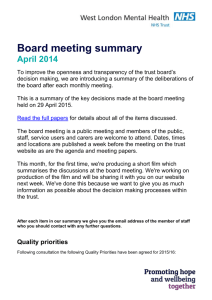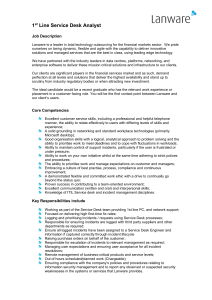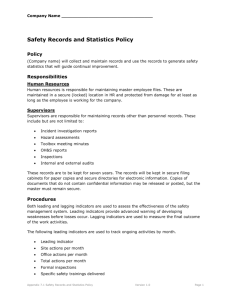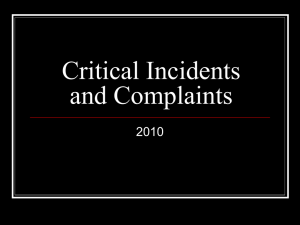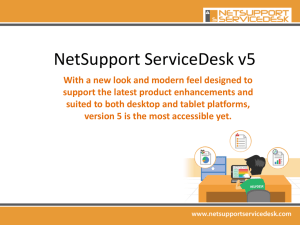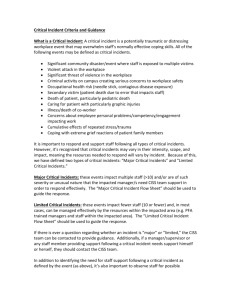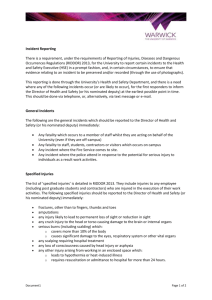2012 PE Magazine - Operations and Safety Solutions
advertisement
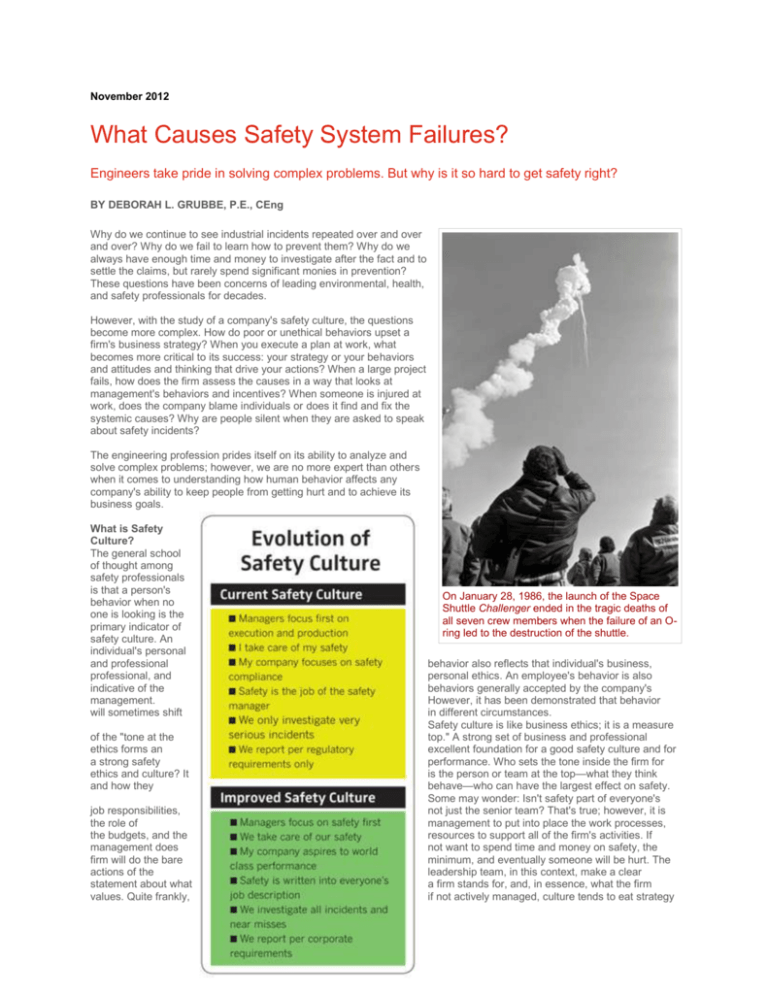
November 2012 What Causes Safety System Failures? Engineers take pride in solving complex problems. But why is it so hard to get safety right? BY DEBORAH L. GRUBBE, P.E., CEng Why do we continue to see industrial incidents repeated over and over and over? Why do we fail to learn how to prevent them? Why do we always have enough time and money to investigate after the fact and to settle the claims, but rarely spend significant monies in prevention? These questions have been concerns of leading environmental, health, and safety professionals for decades. However, with the study of a company's safety culture, the questions become more complex. How do poor or unethical behaviors upset a firm's business strategy? When you execute a plan at work, what becomes more critical to its success: your strategy or your behaviors and attitudes and thinking that drive your actions? When a large project fails, how does the firm assess the causes in a way that looks at management's behaviors and incentives? When someone is injured at work, does the company blame individuals or does it find and fix the systemic causes? Why are people silent when they are asked to speak about safety incidents? The engineering profession prides itself on its ability to analyze and solve complex problems; however, we are no more expert than others when it comes to understanding how human behavior affects any company's ability to keep people from getting hurt and to achieve its business goals. What is Safety Culture? The general school of thought among safety professionals is that a person's behavior when no one is looking is the primary indicator of safety culture. An individual's personal and professional professional, and indicative of the management. will sometimes shift of the "tone at the ethics forms an a strong safety ethics and culture? It and how they job responsibilities, the role of the budgets, and the management does firm will do the bare actions of the statement about what values. Quite frankly, On January 28, 1986, the launch of the Space Shuttle Challenger ended in the tragic deaths of all seven crew members when the failure of an Oring led to the destruction of the shuttle. behavior also reflects that individual's business, personal ethics. An employee's behavior is also behaviors generally accepted by the company's However, it has been demonstrated that behavior in different circumstances. Safety culture is like business ethics; it is a measure top." A strong set of business and professional excellent foundation for a good safety culture and for performance. Who sets the tone inside the firm for is the person or team at the top—what they think behave—who can have the largest effect on safety. Some may wonder: Isn't safety part of everyone's not just the senior team? That's true; however, it is management to put into place the work processes, resources to support all of the firm's activities. If not want to spend time and money on safety, the minimum, and eventually someone will be hurt. The leadership team, in this context, make a clear a firm stands for, and, in essence, what the firm if not actively managed, culture tends to eat strategy for breakfast. A company can have the greatest plan in the world, but if there is a lack of trust or a poor attitude among the leaders, a great strategy will not, in and of itself, ensure a positive business outcome. Safety culture, therefore, is related to more than just good safety performance; it is related to good business performance and solid business principles. Simply stated, safety and safety culture are an investment in a firm's operational discipline and rigor. It involves support and active improvement in key work processes, like proper procedures, rewards, and continuous improvement. All business processes should work together to support strong safety performance and good business outcomes. Safety and good business success work hand in hand. It is very, very rare to find a business where safety performance was poor and business performance was outstanding. If it's not clear already, I have a very strong bias in support of good safety culture, values, and business, as well as operational excellence. Bottom line: If you want to be in business for a long time, you will harvest the seeds you have sown. In essence, a good safety culture is a good balance of short- and long-term business management. If you run your firm exclusively with a short-term focus, you will miss the need to invest in the development of your management team and the workforce skill set needed to effectively renew the business. Why Is Safety so Hard to Get Right? Why do so many firms, even good firms, struggle in establishing good safety and safety culture? The answer rests in how executives think about safety in the business context, and how diligent they are in follow-up. Too often, executive thinking simply misses the mark. Most of the time, executives see safety as a cost rather than as an investment. Additionally, executives miss the concept that their personal interest and views about safety will affect what they spend their time on and the level of attention that their organization will put on safety. If one looks at the costs incurred by any firm after a significant safety event, such as the 2005 explosion at a BP refinery in Texas City, Texas, and after the Deepwater Horizon incident, one could have prevented both of these incidents with a small fraction of the tens of billions spent by BP after the fact. Public reports of these incidents indicate that both incidents were preventable. An explosion at a BP oil refinery in Texas City, Texas, killed 15 workers on March 23, 2005. A report issued in 2007 by an independent investigation found that the company failed to emphasize safety at its U.S. refineries. File Photo By Houston Chronicle / Brett Coomer Safety culture is something that everyone in the company needs to worry about. This may be part of the root cause of why serious incidents keep happening. It is quite possible that many people who do not have the word "safety" in their title believe they don't have to pay attention to safety, or perhaps even have their performance measured. Here are four points to remember: A firm's board of directors has the ultimate responsibility for effectively managing the changing nature of the firm's risk profile and the business' ability to effectively manage that changing profile. Executives and the senior leaders need to ensure that the work processes and systems are in place, robust, and functioning as intended. Middle and first line managers must be trained to execute the work processes with a high level of operating discipline. They also must be able to note what needs to be improved and to make simple improvements in the work processes. Lastly, and most importantly, the workforce must be trained and find the work process easy to follow. The workforce must also believe that their management gives them the freedom to put their safety above production goals. This last point requires a high amount of trust within the organization. Safety Culture Models In today's process industries, there are two well-known safety culture models: the Keil Centre Model and DuPont's Bradley Curve. (Shown in Figure 1 and Figure 2, respectively.) The two models are similar, but not identical, and cover similar concepts. They also make one point clear: It takes a long time to improve a company's safety culture. Even under optimal conditions and leadership, it takes about 18 months to begin to see an improvement in any given safety culture. For example, one poorly executed communication or personnel change can dramatically and negatively send safety culture into a backwards slide. Measuring Safety Culture? It is really quite simple to measure safety culture; just watch behaviors. Experienced professionals can identify a safety culture in a few days' worth of interviews, observations, and audits. Leading firms use measures of their safety culture as part of their biweekly or monthly safety improvement processes. Some firms use yearly surveys. The secret is to be aware, to measure consistently, and to take action to address findings. Here are two possible safety culture questions, and how the potential answers begin to indicate the safety culture. 1. 2. What does your manager do when he/she sees a safety issue? In the poorer safety culture, the manager will ignore the safety problem, while in the better culture the manager will stop immediately, personally address the issue, and follow up later. How robust are your injury and incident reporting processes? Injury and illness reporting procedures are a measure of the organization's aggressiveness toward learning and improvement. The better safety culture will investigate all serious and many minor and near-miss incidents, as the incidents are windows into the weaknesses of work processes and systems that need to be strengthened. The poorer safety cultures will not do a thorough investigation of even the major incidents, and will, most likely, not even worry too much about the near-miss incidents. Being "lucky" shows up a lot in the lexicon of the weaker safety culture, as these firms most likely do not have the work processes to effectively share the lessons from their incidents. Without a strong reporting process, the incidents are bound to be repeated. Effect on Business Outcomes Safety culture has been a contributor to most, if not every, incident that occurs. Humans, who have been known to make errors, are intimately involved in every aspect of a business. The human fingerprint can be found on every serious incident and many minor incidents. Sometimes, the human fingerprint dates back to decisions made decades ago and involves a totally different group of executives and managers. This human fingerprint is found on business and project strategies through operation and decommissioning decisions. The company with the better culture makes sure those fingerprints are discovered and acted upon before they contribute to a serious incident. Understanding these sometimes invisible incident precursors leads to another key safety axiom: "Safety never stays the same. It is always getting better or getting worse." Increasing the Firm's Risk Profile Industries all over the world can be negatively affected if attention isn't paid to safety and safety culture. Long lasting damage can be done to reputations and finances. In fact, poor safety culture can put whole firms out of business or forever alter them. One need look no further than the 1984 incident in Bhopal, India, that led to the end of Union Carbide and the 1988 Piper Alpha tragedy that killed 167 people and resulted in Occidental Petroleum withdrawing from its business in the North Sea and becoming a smaller firm. A more recent example is the reduction of BP's market capitalization and subsequent asset sales after its 2010 Gulf of Mexico incident. In all of these situations, there was a lack of management attention to the barriers present in the work processes and facilities, as some safety systems had been rendered nonoperational. Acute focus had been lost about what barriers were in place and how process safety needed to be managed. Even if you work in the built environment, there are many examples of incidents that have happened because culture and work processes were not robust—think tower crane collapses, structural weaknesses during concrete placement, and not effectively reviewing shop drawings. While safety culture can be viewed as a nebulous characteristic that does not deserve management attention, that very mindset is the first warning on the road to a potential problem. The more prudent senior executive is interested and knowledgeable about how his or her behavior contributes to a stronger safety culture. Smart leaders pay attention to their firm's safety culture and their role in it. Other executives' experience has shown that safety may not be the place to "bet the firm." In the final result, safety culture should be viewed very simply: "Pay me now, or pay me later." NSPE member Deborah L. Grubbe, P.E., CEng, was a consultant on safety culture for the Columbia Shuttle Accident Investigation Board and a member of the NASA Aerospace Safety Advisory Panel from 2003–12. She has over 30 years of executive experience in engineering and operations positions with large multinationals. Characteristics of a Safety Culture If a company has a good safety culture, the business has, most likely, some of these characteristics: Strong environmental, health, and safety performance Smaller fines and fine levels Better relationships with regulators and communities Higher product quality Reduced waste levels and waste treatment costs More reliable and predictive operations and product outcomes Strong cost performance Time available to train people effectively Able to attract the best performers Reduced employee turnover More satisfied customers due to higher reliability of supply and quality Improved profitability

